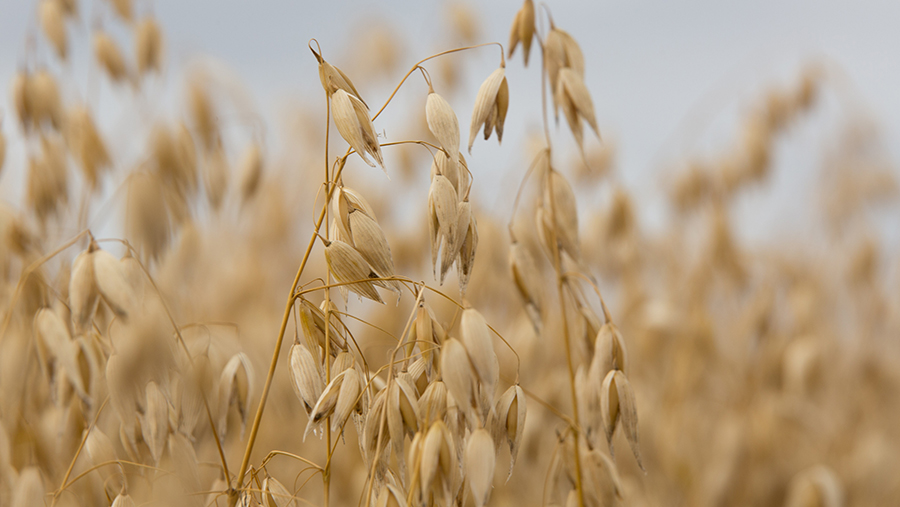How a better understanding of oat agronomy will lift yields
 © Tim Scrivener
© Tim Scrivener Researchers are addressing the urgent need for better agronomy knowledge for spring oats, which has the potential to become a high-yielding breakcrop.
Not only will the new benchmark figures help farmers raise yields, having a better understanding of the crop means achieving good milling quality could become the norm.
The aim should be to fill all the grains that form, says Adas crop physiologist Sarah Clarke.
It means paying attention to seed rate, tiller numbers and the timing of nitrogen applications – all areas that are being investigated in research projects.
“Having too many grains can be detrimental to quality. Getting the right number is important or specific weights will be affected.”
See also: Pigs in the arable rotation – benefits and what to consider
Breakthrough
The launch of the first-ever Oat Growth Guide last summer was a breakthrough, she believes, as it contains growth and development benchmarks for a high yielding crop, dividing them regionally to take account of the longer grain filling period in the north.
The spring oat benchmarks were developed as part of the Opti-Oat Innovate UK project led by Pepsico.
They are based on 20 reference crops and 47 commercial crops, monitored over four years, with the spring oats figures being associated with a 7t/ha crop of Canyon.
Dr Clarke says that they should be used as tool for crop improvement and better understanding of its potential, rather than absolute targets.
“Like other crops, oats grow through the capture and conversion of sunlight and water. We have to understand how to convert that resource capture into yield, which is why the guide is so useful.”
Early benchmarks for spring oats
- Target plant population – 260 plants/sq m
- Shoot numbers at GS 31 – 445/sq m (455 north, 435 south)
- Final shoot number – 370/sq m (380/sq m north, 355/sq m south)
- N uptake – 45kg/ha/green area index unit
Trials work
Research being undertaken by Dr Clarke and the Adas team on spring oats includes work on seed rates and nitrogen requirements – both of which have either been neglected for too long or not investigated before.
“Suffolk trials have shown the benefit of using a higher seed rate in dry establishment conditions, when the crop doesn’t get the chance to tiller as much,” she reports.
“We saw better yields from using 410 seeds/sq m than 325 seeds/sq m in two seasons, as well as a benefit from getting crops in earlier.”
That reflects the crop’s tendency to rattle through the growth stages, she explains, giving little time for key agronomic interventions if it goes in late.
She cautions that the work was done in East Anglia, which is drier than many other parts of the country.
“More general advice is to aim for 260 established plants, which means that you will need a seed rate above 300 seeds/sq m.”
Nutrient requirements
Long-overdue guidance on nitrogen rates and timings for spring oats will be updated once the data has been generated – something that the AHDB and industry-funded NoatS research project is addressing.
Survey results indicate that growers are applying around 120kg of N/ha, with half of that being put in the seed-bed and the remainder before stem extension.
“It is better to split your nitrogen, even though we saw good results from it all being put on the seed-bed in 2019 in the East.
“That’s at odds with previous trials, so our advice is to split the nitrogen and look out for results when we’ve carried out more trials.”
Later nitrogen is beneficial where moisture is available and shows a more consistent effect further north, where the longer grain fill period means higher biomass crops take up more nitrogen, she adds.
When it comes to sulphur, there’s a gap in the knowledge. A yield benefit from applying sulphur has been seen in winter oats grown on light land in Nottinghamshire but wasn’t evident on heavier soils in 2019.
“More trials are planned on sulphur and it should be applied routinely.”
Plant growth regulators should also be split – something which is tricky to do in practice when the crop is growing rapidly.
“Making the first application at growth stage (GS) 31-32 and the second at GS37 is more effective than a single spray.”
Disease control is straightforward in most years, with crown rust and mildew being the main diseases present.
Measuring Shoot Numbers
Final shoot number is an important component of yield.
To assess how your crop is developing, use a 50cm stick placed between two rows and then count the tiller numbers on either side, multiplying up the number based on row width.
Miller feedback
Spring oat varieties are struggling to match “rock solid” winter oat variety Mascani in terms of milling losses and hullability, according to one of the main oat buyers.
The weather conditions for the past two years mean that none of the spring choices have performed particularly well, despite the mill’s eagerness to support the spring sown crop, reports Brin Hughes of Richardsons.
“We would be delighted to take in spring oats with the same hullability and efficiency of processing as Mascani. For this reason, we are always assessing new varieties.”
Trials conducted with Harlow Agricultural Merchants and Zantra for the past two years in Essex and Kent have shown that higher seed rates and higher nitrogen rates have a yield benefit.
Using 400 seeds/sq m instead of 300 resulted in a 0.35t/ha yield lift while increasing nitrogen from 100kg/ha to 150kg/ha gave between 0.5-0.8t/ha, depending on site and variety.
Case Study: Driver Farms, Suffolk

© Tim Scrivener
Spring oats have been a useful breakcrop addition to the rotation at Driver Farms in Suffolk, where they are part of an overall blackgrass control strategy and have earned their place in a flexible system.
Put on the worst blackgrass fields after a crop of spring barley – giving a double break – spring oats have also helped to bring more diversity onto the farm, as grower Adam Driver concentrates on working with nature in a reduced and no-till system.
With 600ha of spring cropping on the 1,150ha farm, he is mindful of the effects of a spring drought on crop performance, so aims to drill between mid-February and mid-March.
“The earlier the better,” he says. “Oats are resilient enough to work well in a no-till system. We usually do a light cultivation followed by a broadcast cover crop, before using cleaned farm-saved seed with no dressing.”
He budgets for a yield of 6.5t/ha and aims for 7.5t/ha, although on the poorest land in a droughty year they struggle to do more than 5t/ha.
Mr Driver has also tried using a stripper header in spring oats at harvest, so that he can direct drill the next crop into standing straw without any hair-pinning issues.
“Experience to date suggests that it allows us to get on a couple of days earlier,” he says.
“It is necessary to use a disc drill after the stripper header, but we were impressed with the results. The jury is still out on whether the thatch left impeded herbicide performance.”
In terms of input use on spring oats, Mr Driver uses 120-130kg/ha of nitrogen, putting half of it down the spout at drilling.
The remainder goes on a couple of weeks later, with sap testing and micronutrient applications also carried out on the rapidly developing crop.
“I’m not sure the latter adds any margin in spring crops.”
His aim is to keep crop management simple and as cheap as possible.
“Spring oats only give small responses to fungicides, so we’ll use one application of either tebuconazole or epoxiconazole. If it turns wet, we might make a second application.”
Otherwise he applies an early treatment of chlormequat and one herbicide for broad-leaved weeds. “Oats are sensitive, so you need to remember that when devising a spray plan.”
He has grown both Canyon and Elyann in the past, with similar results, but doesn’t plan to drill any spring oats this year.
“I’m concerned that the market could be over-supplied this year given the wet autumn and winter, so we opted for oilseed rape instead and drilled it in early autumn.”
Mr Driver’s final point is that he believes successful and profitable spring crops are mostly down to good establishment and favourable weather conditions, not input strategies.
The Oat Growth Guide is available free of charge and can be downloaded from the PepsiCo website.

